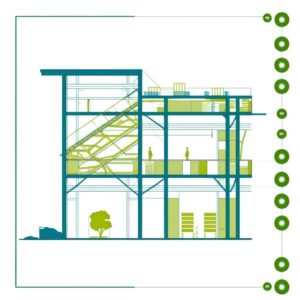A hydrographic survey is the process of measuring and mapping underwater features, including the depth, shape, and contours of seabeds, riverbeds, lakes, and reservoirs. Using advanced instruments like sonar, echo sounders, and GPS systems, hydrographic surveys produce detailed charts and models of water bodies.
As infrastructure, maritime trade, and environmental monitoring continue to grow in complexity, understanding water bodies is more critical than ever. This is where hydrographic surveys come into play. These specialized surveys map underwater features, measure water depth, and provide essential data for safe navigation, engineering, and resource management.
This data helps inform decisions for port construction, dredging, marine navigation, pipeline installation, bridge design, and environmental conservation.
Why Are Hydrographic Surveys Important?
Hydrographic surveys serve as the foundation for various water-related activities, offering benefits such as:
- Safe Navigation: Updated depth charts reduce the risk of grounding and collisions for ships.
- Port and Harbor Development: Enables efficient planning of docks, jetties, and cargo terminals.
- Dredging Operations: Identifies siltation zones and helps in planning excavation work.
- Flood Control and Water Management: Supports the design of embankments, reservoirs, and drainage systems.
- Environmental Monitoring: Assists in identifying sediment changes, erosion patterns, and aquatic habitats.
- Offshore Infrastructure: Facilitates the placement of oil rigs, wind turbines, and underwater cables or pipelines.
Technologies & Equipment Used in Hydrographic Surveying
Modern hydrographic surveys use a combination of surface and underwater technologies to gather data efficiently and accurately. Key tools include:
🔸 Single-Beam and Multi-Beam Echo Sounders
Used to measure water depth. Multi-beam systems offer wider coverage and more precise mapping.
🔸 Side-Scan Sonar
Captures detailed images of the seabed surface to detect objects, features, or debris.
🔸 Differential GPS (DGPS)
Provides high-accuracy positioning, ensuring all underwater measurements are geographically correct.
🔸 Sound Velocity Profilers (SVPs)
Measures the speed of sound through water, which is essential for accurate sonar readings.
🔸 Tide Gauges
Monitor water levels to correct depth readings for tidal variations.
🔸 GIS and Data Processing Software
Used to generate charts, digital elevation models (DEMs), and bathymetric maps from raw survey data.
Applications of Hydrographic Surveys Across Sectors
Hydrographic data is widely used across multiple industries:
✅ Maritime and Port Authorities
Hydrographic surveys support port construction, ship navigation, anchorage studies, and channel maintenance.
✅ Inland Waterways and River Management
These surveys help manage sedimentation, floodplain mapping, and waterway development.
✅ Offshore Energy and Telecommunications
Accurate seabed data is essential for laying underwater cables, pipelines, and offshore wind farms.
✅ Hydropower and Irrigation Projects
Surveys support dam design, reservoir capacity studies, and siltation monitoring.
✅ Coastal and Environmental Studies
Used for shoreline monitoring, mangrove mapping, and tracking ecological changes over time.
Benefits of Professional Hydrographic Survey Services
- High data accuracy and reliable reports
- Use of industry-standard software and equipment
- Skilled surveyors with knowledge of terrain, tides, and marine conditions
- Timely project delivery for engineering, compliance, or operational needs
Whether you’re planning a port expansion or monitoring sediment flow in a river, hydrographic surveys provide the underwater clarity you need to make informed decisions.
Hydrographic surveys are vital for managing and developing India’s vast network of rivers, lakes, and coastlines. As maritime trade, inland navigation, and water-based infrastructure projects continue to expand, the need for accurate and efficient underwater data will only increase.
We are proud to offer expert hydrographic survey services across India, catering to a wide range of industries. Our services include precise mapping of water bodies, measuring water depth, and analyzing underwater features to support projects in maritime navigation, infrastructure development, environmental conservation, and resource management. Equipped with state-of-the-art technology and a team of experienced professionals, we ensure accurate and reliable survey data that help businesses and government agencies make informed decisions. Whether it’s for port construction, river management, or offshore operations, we provide comprehensive hydrographic survey solutions to meet the unique needs of each project.





